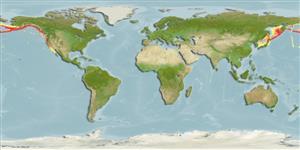Classification / Names
Common names from other countries
Main reference
Size / Weight / Age
Max length : 80.0 cm SL male/unsexed; (Ref. 559); max. published weight: 9.0 kg (Ref. 56527); max. reported age: 100 years (Ref. 90032)
Length at first maturity
Lm 22.0 range ? - ? cm
Environment
Marine; demersal; depth range 17 - 1600 m (Ref. 50550), usually 91 - ? m (Ref. 2850)
Climate / Range
Temperate, preferred 5°C (Ref. 107945)
Distribution
North Pacific: Sea of Okhotsk north to the Navarin Canyon in the Bering Sea and from Stalemate Bank and Ulm Plateau in the Aleutian Islands southeast to Cedros Island, Baja California, Mexico. Reported from Japan (Ref. 559).
Countries | FAO areas | Ecosystems | Occurrences | Introductions
Short description
Dorsal
spines
(total): 15 - 17;
Dorsal
soft rays
(total): 8-9;
Anal
spines: 3;
Anal
soft rays: 4 - 5. Head spines very strong - nasal, preocular, supraocular, postocular, tympanic, parietal and nuchal spines present, coronal spines absent; large head and elongate body; strong spiny ridge on head; 3rd dorsal spine not much longer than 2nd, 4th or 5th; strong notch on pectoral fin (Ref. 27437). Bright red with some black on fins; gill chamber mostly pale (Ref. 27437). Caudal slightly rounded (Ref. 6885).
IUCN Red List Status (Ref. 115185)
Human uses
Fisheries: minor commercial
More information
ReferencesAquacultureAquaculture profileStrainsGeneticsAllele frequenciesHeritabilityDiseasesProcessingMass conversion
Tools
Special reports
Download XML
Internet sources
Estimates of some properties based on models
Phylogenetic diversity index
PD50 = 0.6250 many relatives (e.g. carps) 0.5 - 2.0 few relatives (e.g. lungfishes)
Trophic Level
3.6 ±0.3 se; Based on diet studies.
Resilience
Very Low, minimum population doubling time more than 14 years (tmax> 100 (validated age: 62 yrs); tm= 13; Fec > 10,000)
Vulnerability
High to very high vulnerability (70 of 100)
Price category
